BUACC1508 Group Assignment: Financial Analysis of Billabong Ltd
VerifiedAdded on 2022/11/24
|13
|3131
|334
Report
AI Summary
This report presents a financial analysis of Billabong Ltd, evaluating its performance from 2016 to 2018. The analysis covers profitability, liquidity, efficiency, leverage, and investment aspects of the company. The report calculates and interprets various financial ratios, including gross profit margin, net profit margin, current ratio, quick ratio, total asset turnover, inventory turnover, debt ratio, equity ratio, and earnings per share. The findings reveal that Billabong Ltd experienced losses during the analyzed period, has a high leverage, and low efficiency. The report concludes with a recommendation against investing in Billabong Ltd under the current circumstances, highlighting the need for the company to improve its financial performance. The data used in the report is sourced from the company's annual reports.
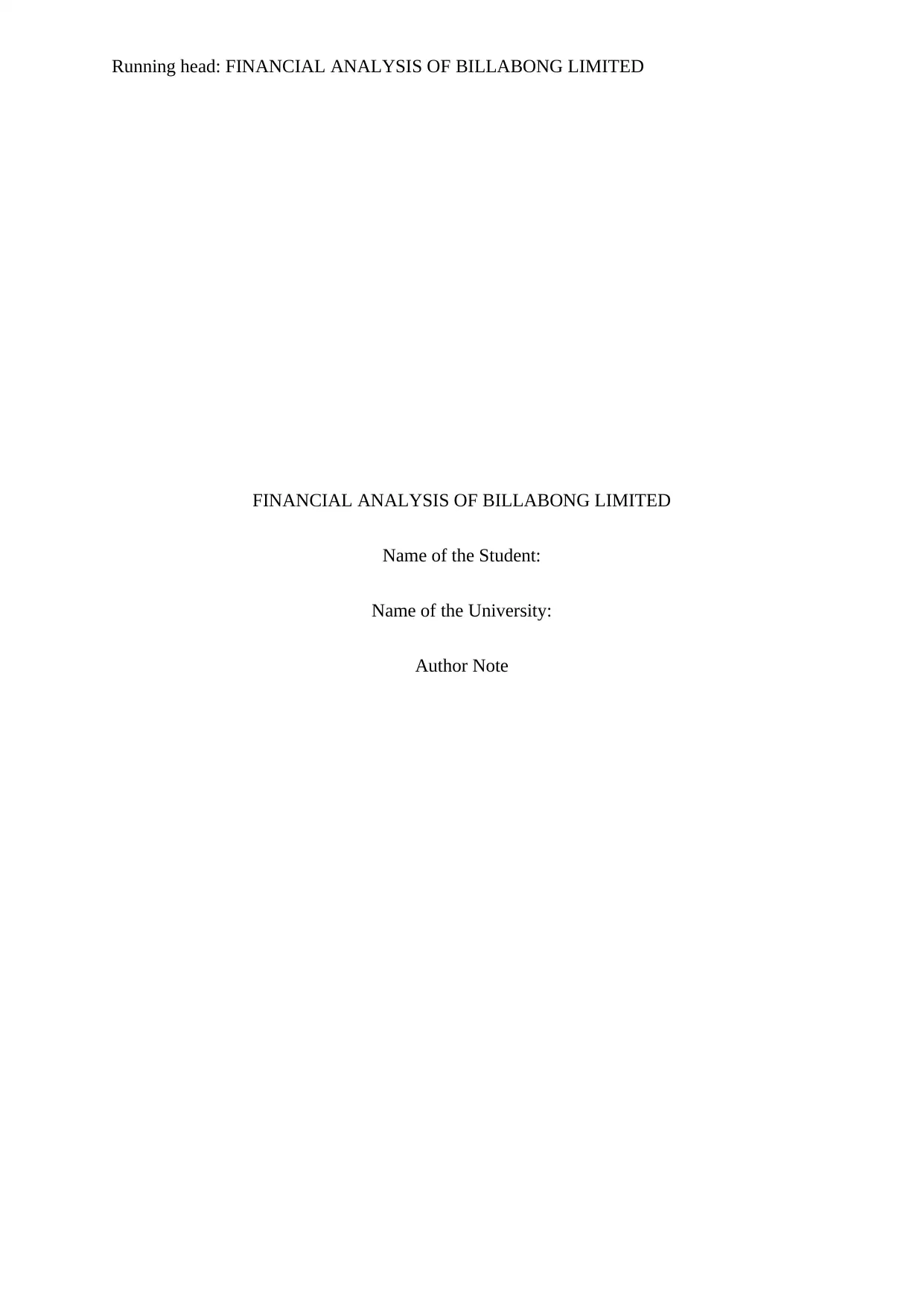
Running head: FINANCIAL ANALYSIS OF BILLABONG LIMITED
FINANCIAL ANALYSIS OF BILLABONG LIMITED
Name of the Student:
Name of the University:
Author Note
FINANCIAL ANALYSIS OF BILLABONG LIMITED
Name of the Student:
Name of the University:
Author Note
Paraphrase This Document
Need a fresh take? Get an instant paraphrase of this document with our AI Paraphraser
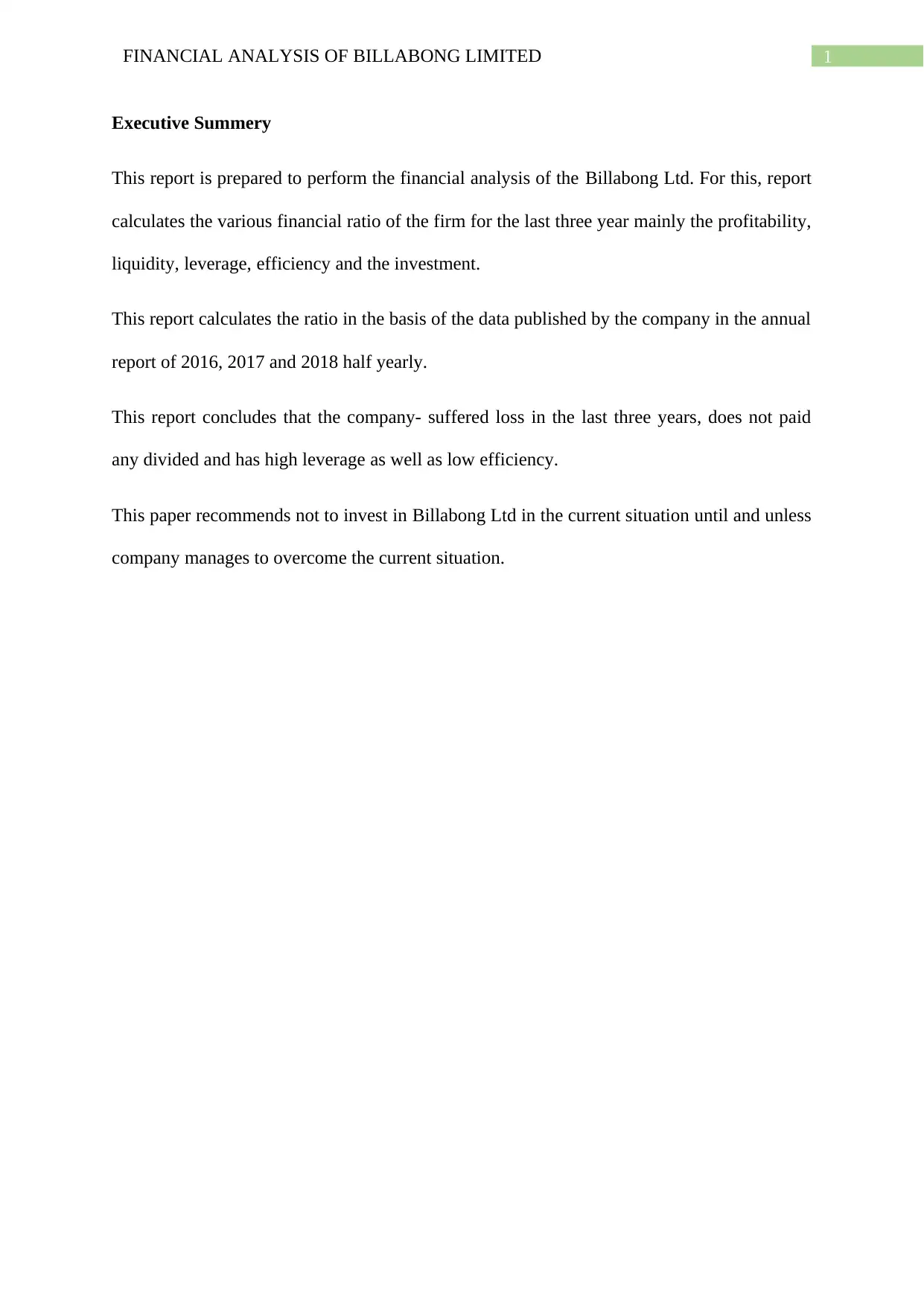
1FINANCIAL ANALYSIS OF BILLABONG LIMITED
Executive Summery
This report is prepared to perform the financial analysis of the Billabong Ltd. For this, report
calculates the various financial ratio of the firm for the last three year mainly the profitability,
liquidity, leverage, efficiency and the investment.
This report calculates the ratio in the basis of the data published by the company in the annual
report of 2016, 2017 and 2018 half yearly.
This report concludes that the company- suffered loss in the last three years, does not paid
any divided and has high leverage as well as low efficiency.
This paper recommends not to invest in Billabong Ltd in the current situation until and unless
company manages to overcome the current situation.
Executive Summery
This report is prepared to perform the financial analysis of the Billabong Ltd. For this, report
calculates the various financial ratio of the firm for the last three year mainly the profitability,
liquidity, leverage, efficiency and the investment.
This report calculates the ratio in the basis of the data published by the company in the annual
report of 2016, 2017 and 2018 half yearly.
This report concludes that the company- suffered loss in the last three years, does not paid
any divided and has high leverage as well as low efficiency.
This paper recommends not to invest in Billabong Ltd in the current situation until and unless
company manages to overcome the current situation.
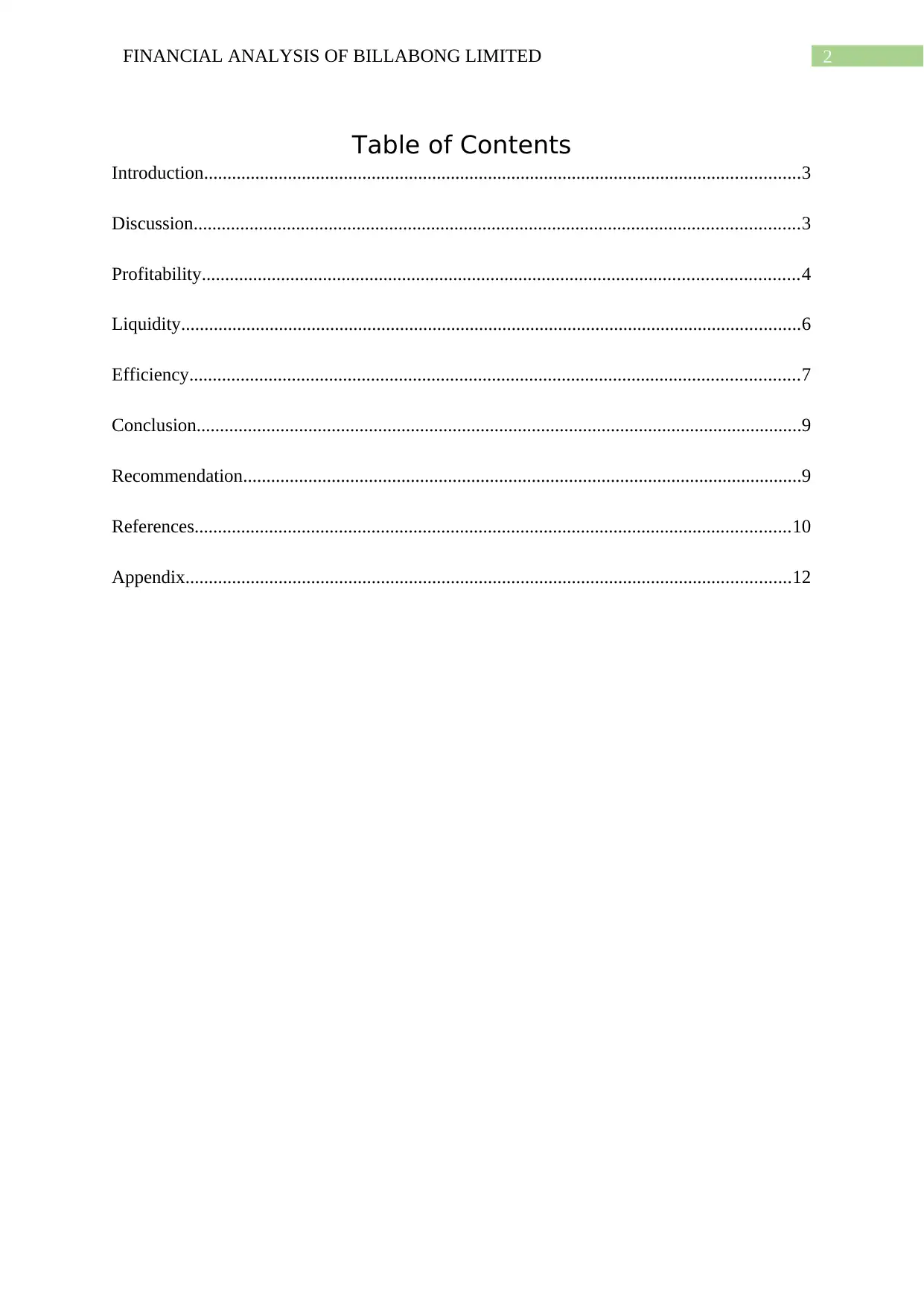
2FINANCIAL ANALYSIS OF BILLABONG LIMITED
Table of Contents
Introduction................................................................................................................................3
Discussion..................................................................................................................................3
Profitability................................................................................................................................4
Liquidity.....................................................................................................................................6
Efficiency...................................................................................................................................7
Conclusion..................................................................................................................................9
Recommendation........................................................................................................................9
References................................................................................................................................10
Appendix..................................................................................................................................12
Table of Contents
Introduction................................................................................................................................3
Discussion..................................................................................................................................3
Profitability................................................................................................................................4
Liquidity.....................................................................................................................................6
Efficiency...................................................................................................................................7
Conclusion..................................................................................................................................9
Recommendation........................................................................................................................9
References................................................................................................................................10
Appendix..................................................................................................................................12
⊘ This is a preview!⊘
Do you want full access?
Subscribe today to unlock all pages.

Trusted by 1+ million students worldwide

3FINANCIAL ANALYSIS OF BILLABONG LIMITED
Introduction
The report titled “Financial Analysis Of Billabong Limited” is prepared to analyse the
financial performance of the Billabong Limited. This report takes into account the financial
performance of the in the year 2016, 2017 and the 2018 (Half yearly) that is for 31st
December 2018. The report analyse the financial performance of the company in terms of
Profitability, Liquidity, Efficiency, leverage and Investment. To performance the financial
analysis of firm, this report perform the various ratio analysis that includes Gross profit
margin, Net profit margin, Current ratio, Quick ratio, Total asset turnover, Inventory
turnover, Debt ratio, Equity ratio and the Earning per share. The Billabong Ltd is an
Australian based merchandise company, which was initially deals with clothing. Laterally,
the company expand its business and stated dealing with the other items like skate boat,
watches, snowboard and backpacks. Gordon and Rena Merchant founder the firm in the year
1973. Billabong Ltd. works in various countries under the different brand names. The
registered office of the firm is situated in Queensland, Australia. This report analysis the each
financial section of the Billabong Ltd to recommend the investors of the firm regarding their
investment decision. The all figure in this report is taken from the annual report of the
company for the 2016, 2017 and 2018 (Half yearly). While, all the figures are in Australian
dollars and thousands.
Discussion
The financial analysis is a tool to analyse the performance of the in terms of the
Profitability, Liquidity, Efficiency, leverage and Investment. This helps the management of
the firm to make the several business decision as per the performance of the firm. This also
helps the stakeholders of the company to make their investment related decision (Zainudin &
Hashim, 2016). To analyse the financial performance of the company, this company uses the
Introduction
The report titled “Financial Analysis Of Billabong Limited” is prepared to analyse the
financial performance of the Billabong Limited. This report takes into account the financial
performance of the in the year 2016, 2017 and the 2018 (Half yearly) that is for 31st
December 2018. The report analyse the financial performance of the company in terms of
Profitability, Liquidity, Efficiency, leverage and Investment. To performance the financial
analysis of firm, this report perform the various ratio analysis that includes Gross profit
margin, Net profit margin, Current ratio, Quick ratio, Total asset turnover, Inventory
turnover, Debt ratio, Equity ratio and the Earning per share. The Billabong Ltd is an
Australian based merchandise company, which was initially deals with clothing. Laterally,
the company expand its business and stated dealing with the other items like skate boat,
watches, snowboard and backpacks. Gordon and Rena Merchant founder the firm in the year
1973. Billabong Ltd. works in various countries under the different brand names. The
registered office of the firm is situated in Queensland, Australia. This report analysis the each
financial section of the Billabong Ltd to recommend the investors of the firm regarding their
investment decision. The all figure in this report is taken from the annual report of the
company for the 2016, 2017 and 2018 (Half yearly). While, all the figures are in Australian
dollars and thousands.
Discussion
The financial analysis is a tool to analyse the performance of the in terms of the
Profitability, Liquidity, Efficiency, leverage and Investment. This helps the management of
the firm to make the several business decision as per the performance of the firm. This also
helps the stakeholders of the company to make their investment related decision (Zainudin &
Hashim, 2016). To analyse the financial performance of the company, this company uses the
Paraphrase This Document
Need a fresh take? Get an instant paraphrase of this document with our AI Paraphraser
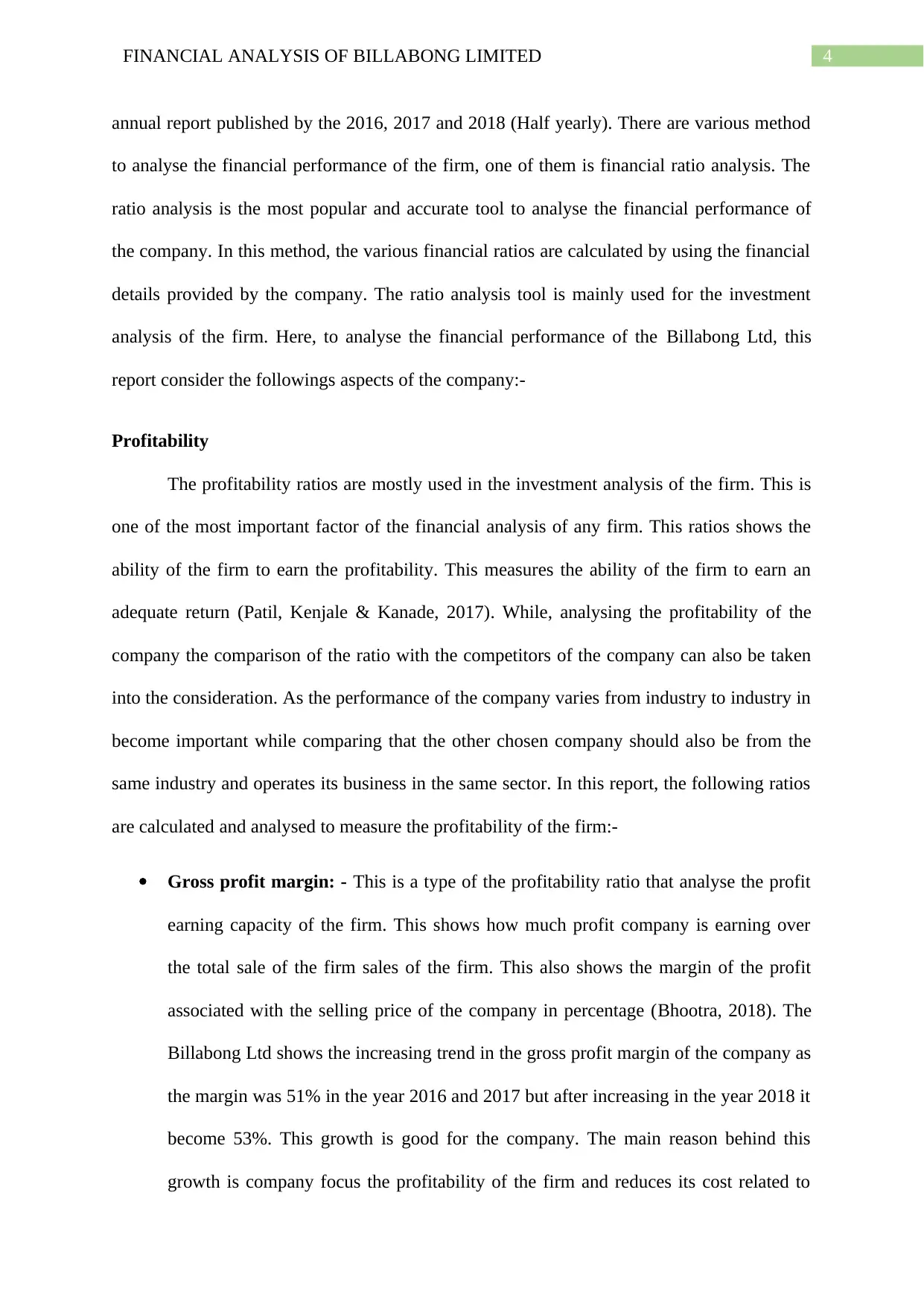
4FINANCIAL ANALYSIS OF BILLABONG LIMITED
annual report published by the 2016, 2017 and 2018 (Half yearly). There are various method
to analyse the financial performance of the firm, one of them is financial ratio analysis. The
ratio analysis is the most popular and accurate tool to analyse the financial performance of
the company. In this method, the various financial ratios are calculated by using the financial
details provided by the company. The ratio analysis tool is mainly used for the investment
analysis of the firm. Here, to analyse the financial performance of the Billabong Ltd, this
report consider the followings aspects of the company:-
Profitability
The profitability ratios are mostly used in the investment analysis of the firm. This is
one of the most important factor of the financial analysis of any firm. This ratios shows the
ability of the firm to earn the profitability. This measures the ability of the firm to earn an
adequate return (Patil, Kenjale & Kanade, 2017). While, analysing the profitability of the
company the comparison of the ratio with the competitors of the company can also be taken
into the consideration. As the performance of the company varies from industry to industry in
become important while comparing that the other chosen company should also be from the
same industry and operates its business in the same sector. In this report, the following ratios
are calculated and analysed to measure the profitability of the firm:-
Gross profit margin: - This is a type of the profitability ratio that analyse the profit
earning capacity of the firm. This shows how much profit company is earning over
the total sale of the firm sales of the firm. This also shows the margin of the profit
associated with the selling price of the company in percentage (Bhootra, 2018). The
Billabong Ltd shows the increasing trend in the gross profit margin of the company as
the margin was 51% in the year 2016 and 2017 but after increasing in the year 2018 it
become 53%. This growth is good for the company. The main reason behind this
growth is company focus the profitability of the firm and reduces its cost related to
annual report published by the 2016, 2017 and 2018 (Half yearly). There are various method
to analyse the financial performance of the firm, one of them is financial ratio analysis. The
ratio analysis is the most popular and accurate tool to analyse the financial performance of
the company. In this method, the various financial ratios are calculated by using the financial
details provided by the company. The ratio analysis tool is mainly used for the investment
analysis of the firm. Here, to analyse the financial performance of the Billabong Ltd, this
report consider the followings aspects of the company:-
Profitability
The profitability ratios are mostly used in the investment analysis of the firm. This is
one of the most important factor of the financial analysis of any firm. This ratios shows the
ability of the firm to earn the profitability. This measures the ability of the firm to earn an
adequate return (Patil, Kenjale & Kanade, 2017). While, analysing the profitability of the
company the comparison of the ratio with the competitors of the company can also be taken
into the consideration. As the performance of the company varies from industry to industry in
become important while comparing that the other chosen company should also be from the
same industry and operates its business in the same sector. In this report, the following ratios
are calculated and analysed to measure the profitability of the firm:-
Gross profit margin: - This is a type of the profitability ratio that analyse the profit
earning capacity of the firm. This shows how much profit company is earning over
the total sale of the firm sales of the firm. This also shows the margin of the profit
associated with the selling price of the company in percentage (Bhootra, 2018). The
Billabong Ltd shows the increasing trend in the gross profit margin of the company as
the margin was 51% in the year 2016 and 2017 but after increasing in the year 2018 it
become 53%. This growth is good for the company. The main reason behind this
growth is company focus the profitability of the firm and reduces its cost related to
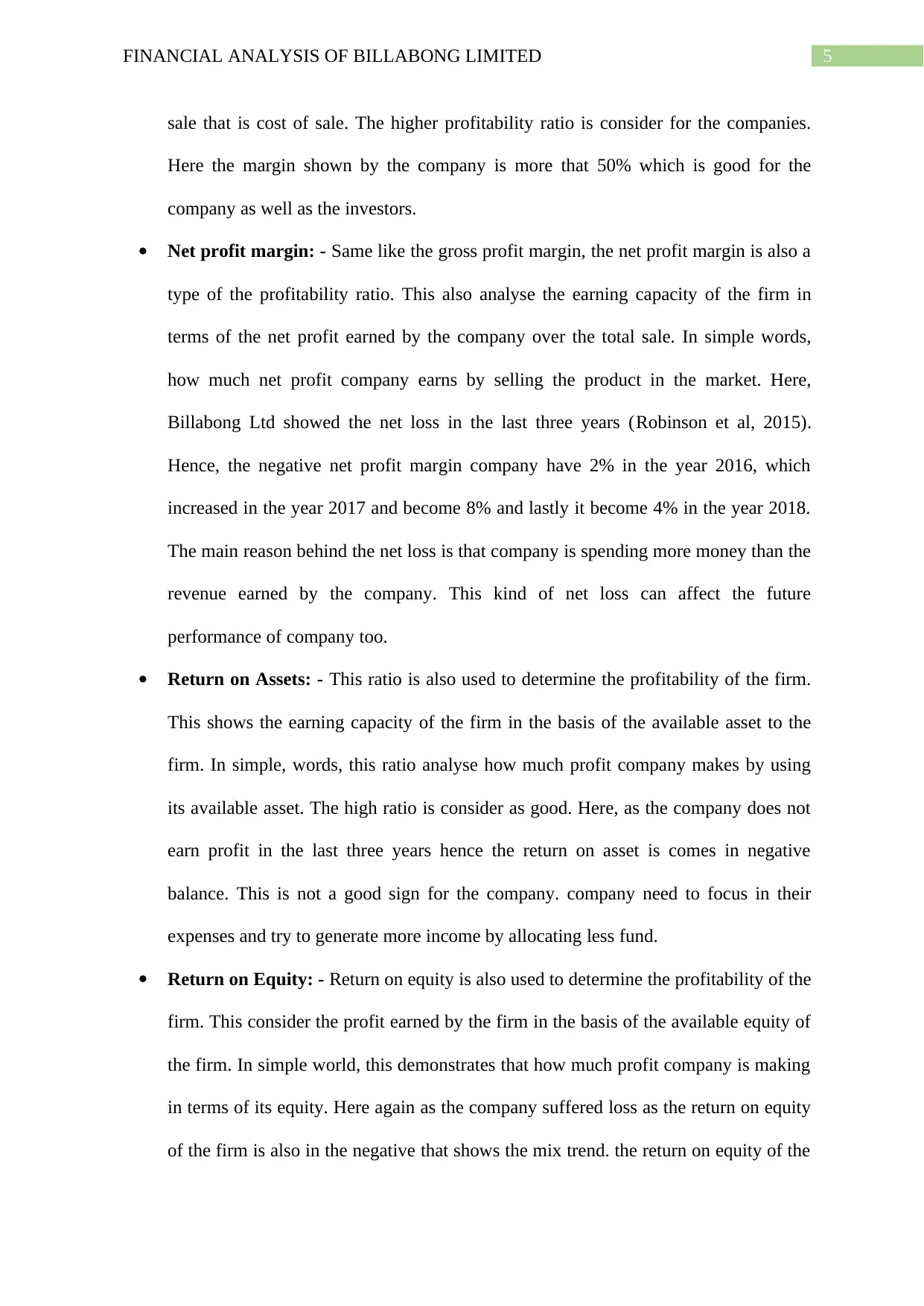
5FINANCIAL ANALYSIS OF BILLABONG LIMITED
sale that is cost of sale. The higher profitability ratio is consider for the companies.
Here the margin shown by the company is more that 50% which is good for the
company as well as the investors.
Net profit margin: - Same like the gross profit margin, the net profit margin is also a
type of the profitability ratio. This also analyse the earning capacity of the firm in
terms of the net profit earned by the company over the total sale. In simple words,
how much net profit company earns by selling the product in the market. Here,
Billabong Ltd showed the net loss in the last three years (Robinson et al, 2015).
Hence, the negative net profit margin company have 2% in the year 2016, which
increased in the year 2017 and become 8% and lastly it become 4% in the year 2018.
The main reason behind the net loss is that company is spending more money than the
revenue earned by the company. This kind of net loss can affect the future
performance of company too.
Return on Assets: - This ratio is also used to determine the profitability of the firm.
This shows the earning capacity of the firm in the basis of the available asset to the
firm. In simple, words, this ratio analyse how much profit company makes by using
its available asset. The high ratio is consider as good. Here, as the company does not
earn profit in the last three years hence the return on asset is comes in negative
balance. This is not a good sign for the company. company need to focus in their
expenses and try to generate more income by allocating less fund.
Return on Equity: - Return on equity is also used to determine the profitability of the
firm. This consider the profit earned by the firm in the basis of the available equity of
the firm. In simple world, this demonstrates that how much profit company is making
in terms of its equity. Here again as the company suffered loss as the return on equity
of the firm is also in the negative that shows the mix trend. the return on equity of the
sale that is cost of sale. The higher profitability ratio is consider for the companies.
Here the margin shown by the company is more that 50% which is good for the
company as well as the investors.
Net profit margin: - Same like the gross profit margin, the net profit margin is also a
type of the profitability ratio. This also analyse the earning capacity of the firm in
terms of the net profit earned by the company over the total sale. In simple words,
how much net profit company earns by selling the product in the market. Here,
Billabong Ltd showed the net loss in the last three years (Robinson et al, 2015).
Hence, the negative net profit margin company have 2% in the year 2016, which
increased in the year 2017 and become 8% and lastly it become 4% in the year 2018.
The main reason behind the net loss is that company is spending more money than the
revenue earned by the company. This kind of net loss can affect the future
performance of company too.
Return on Assets: - This ratio is also used to determine the profitability of the firm.
This shows the earning capacity of the firm in the basis of the available asset to the
firm. In simple, words, this ratio analyse how much profit company makes by using
its available asset. The high ratio is consider as good. Here, as the company does not
earn profit in the last three years hence the return on asset is comes in negative
balance. This is not a good sign for the company. company need to focus in their
expenses and try to generate more income by allocating less fund.
Return on Equity: - Return on equity is also used to determine the profitability of the
firm. This consider the profit earned by the firm in the basis of the available equity of
the firm. In simple world, this demonstrates that how much profit company is making
in terms of its equity. Here again as the company suffered loss as the return on equity
of the firm is also in the negative that shows the mix trend. the return on equity of the
⊘ This is a preview!⊘
Do you want full access?
Subscribe today to unlock all pages.

Trusted by 1+ million students worldwide

6FINANCIAL ANALYSIS OF BILLABONG LIMITED
Billabong Ltd is (0.03), (0.36) and (0.11) in the year 2016, 2017 and 2018
respectively. This kind of return on equity is really a biggest concern for the company.
Billabong Ltd need to solve this as soon as possible for the future prospective of the
business.
Liquidity
This is second most important ratio for the investment analysis or the financial
analysis of the firm. This shows the ability of the firm to meet its current liabilities or the
obligations. This also shows how many assets company need to sell to meet its liabilities.
This helps the investors to understand the liquidity or the paying capacity of the company.
The following ratios are calculated and analysed to know the liquidity of the firm:-
Current Ratio: - This is the part of the liquidity ratio. This shows the ability of the
firm to meet its current liabilities and obligation by selling its available current
assets. The ideal current ratio is 1 (Anwar, Fathoni & Gagah, 2018). Here, the
Billabong Ltd shows the 2.26, 2.42, 2.29 as the current ratio in the year 2018, 2017
and 2016 respectively. As the company has high current ratio more than 2 in the last
three year but the high current ratio is also not consider as good. The high current
ratio shows that the company is not using its available current assets.
Quick Ratio: - Same like the current ratio, quick ratio also used to measure the
liquidity of the firm. This also reveals the ability of the company to meet its liability
by using its quick assets. The ideal ratio for this is also 1 and the high ratio is
consider as good but not all time. Here, the Billabong Ltd shows the decreasing trend
in their quick ratio. Here, this decreasing trend is consider as good because company
has high quick ratio that is not good for the company.
Net Working Capital: - This is also a type of the liquidity ratio, which measures the
liquidity of the company. The net working capital shows the difference between the
Billabong Ltd is (0.03), (0.36) and (0.11) in the year 2016, 2017 and 2018
respectively. This kind of return on equity is really a biggest concern for the company.
Billabong Ltd need to solve this as soon as possible for the future prospective of the
business.
Liquidity
This is second most important ratio for the investment analysis or the financial
analysis of the firm. This shows the ability of the firm to meet its current liabilities or the
obligations. This also shows how many assets company need to sell to meet its liabilities.
This helps the investors to understand the liquidity or the paying capacity of the company.
The following ratios are calculated and analysed to know the liquidity of the firm:-
Current Ratio: - This is the part of the liquidity ratio. This shows the ability of the
firm to meet its current liabilities and obligation by selling its available current
assets. The ideal current ratio is 1 (Anwar, Fathoni & Gagah, 2018). Here, the
Billabong Ltd shows the 2.26, 2.42, 2.29 as the current ratio in the year 2018, 2017
and 2016 respectively. As the company has high current ratio more than 2 in the last
three year but the high current ratio is also not consider as good. The high current
ratio shows that the company is not using its available current assets.
Quick Ratio: - Same like the current ratio, quick ratio also used to measure the
liquidity of the firm. This also reveals the ability of the company to meet its liability
by using its quick assets. The ideal ratio for this is also 1 and the high ratio is
consider as good but not all time. Here, the Billabong Ltd shows the decreasing trend
in their quick ratio. Here, this decreasing trend is consider as good because company
has high quick ratio that is not good for the company.
Net Working Capital: - This is also a type of the liquidity ratio, which measures the
liquidity of the company. The net working capital shows the difference between the
Paraphrase This Document
Need a fresh take? Get an instant paraphrase of this document with our AI Paraphraser
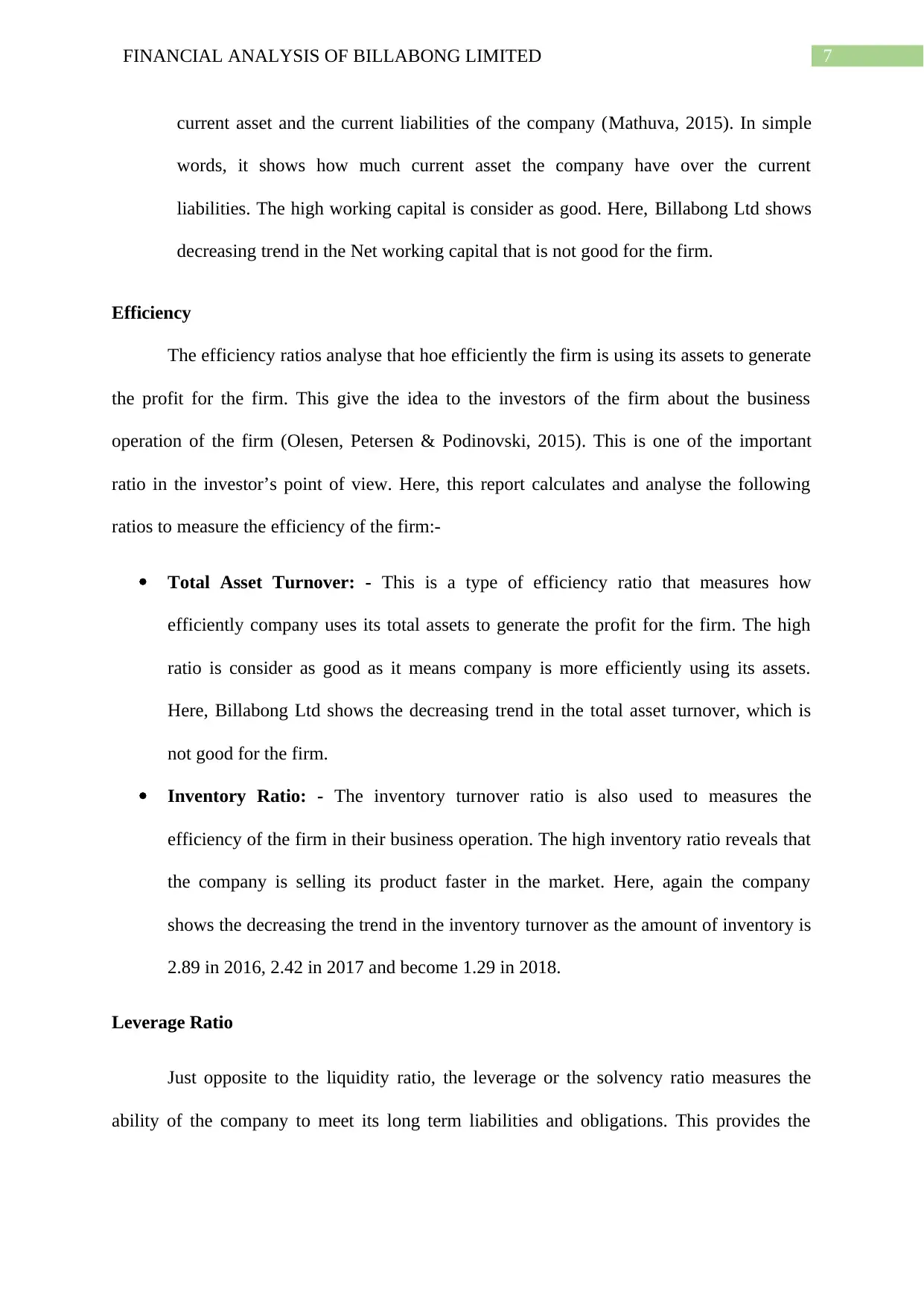
7FINANCIAL ANALYSIS OF BILLABONG LIMITED
current asset and the current liabilities of the company (Mathuva, 2015). In simple
words, it shows how much current asset the company have over the current
liabilities. The high working capital is consider as good. Here, Billabong Ltd shows
decreasing trend in the Net working capital that is not good for the firm.
Efficiency
The efficiency ratios analyse that hoe efficiently the firm is using its assets to generate
the profit for the firm. This give the idea to the investors of the firm about the business
operation of the firm (Olesen, Petersen & Podinovski, 2015). This is one of the important
ratio in the investor’s point of view. Here, this report calculates and analyse the following
ratios to measure the efficiency of the firm:-
Total Asset Turnover: - This is a type of efficiency ratio that measures how
efficiently company uses its total assets to generate the profit for the firm. The high
ratio is consider as good as it means company is more efficiently using its assets.
Here, Billabong Ltd shows the decreasing trend in the total asset turnover, which is
not good for the firm.
Inventory Ratio: - The inventory turnover ratio is also used to measures the
efficiency of the firm in their business operation. The high inventory ratio reveals that
the company is selling its product faster in the market. Here, again the company
shows the decreasing the trend in the inventory turnover as the amount of inventory is
2.89 in 2016, 2.42 in 2017 and become 1.29 in 2018.
Leverage Ratio
Just opposite to the liquidity ratio, the leverage or the solvency ratio measures the
ability of the company to meet its long term liabilities and obligations. This provides the
current asset and the current liabilities of the company (Mathuva, 2015). In simple
words, it shows how much current asset the company have over the current
liabilities. The high working capital is consider as good. Here, Billabong Ltd shows
decreasing trend in the Net working capital that is not good for the firm.
Efficiency
The efficiency ratios analyse that hoe efficiently the firm is using its assets to generate
the profit for the firm. This give the idea to the investors of the firm about the business
operation of the firm (Olesen, Petersen & Podinovski, 2015). This is one of the important
ratio in the investor’s point of view. Here, this report calculates and analyse the following
ratios to measure the efficiency of the firm:-
Total Asset Turnover: - This is a type of efficiency ratio that measures how
efficiently company uses its total assets to generate the profit for the firm. The high
ratio is consider as good as it means company is more efficiently using its assets.
Here, Billabong Ltd shows the decreasing trend in the total asset turnover, which is
not good for the firm.
Inventory Ratio: - The inventory turnover ratio is also used to measures the
efficiency of the firm in their business operation. The high inventory ratio reveals that
the company is selling its product faster in the market. Here, again the company
shows the decreasing the trend in the inventory turnover as the amount of inventory is
2.89 in 2016, 2.42 in 2017 and become 1.29 in 2018.
Leverage Ratio
Just opposite to the liquidity ratio, the leverage or the solvency ratio measures the
ability of the company to meet its long term liabilities and obligations. This provides the
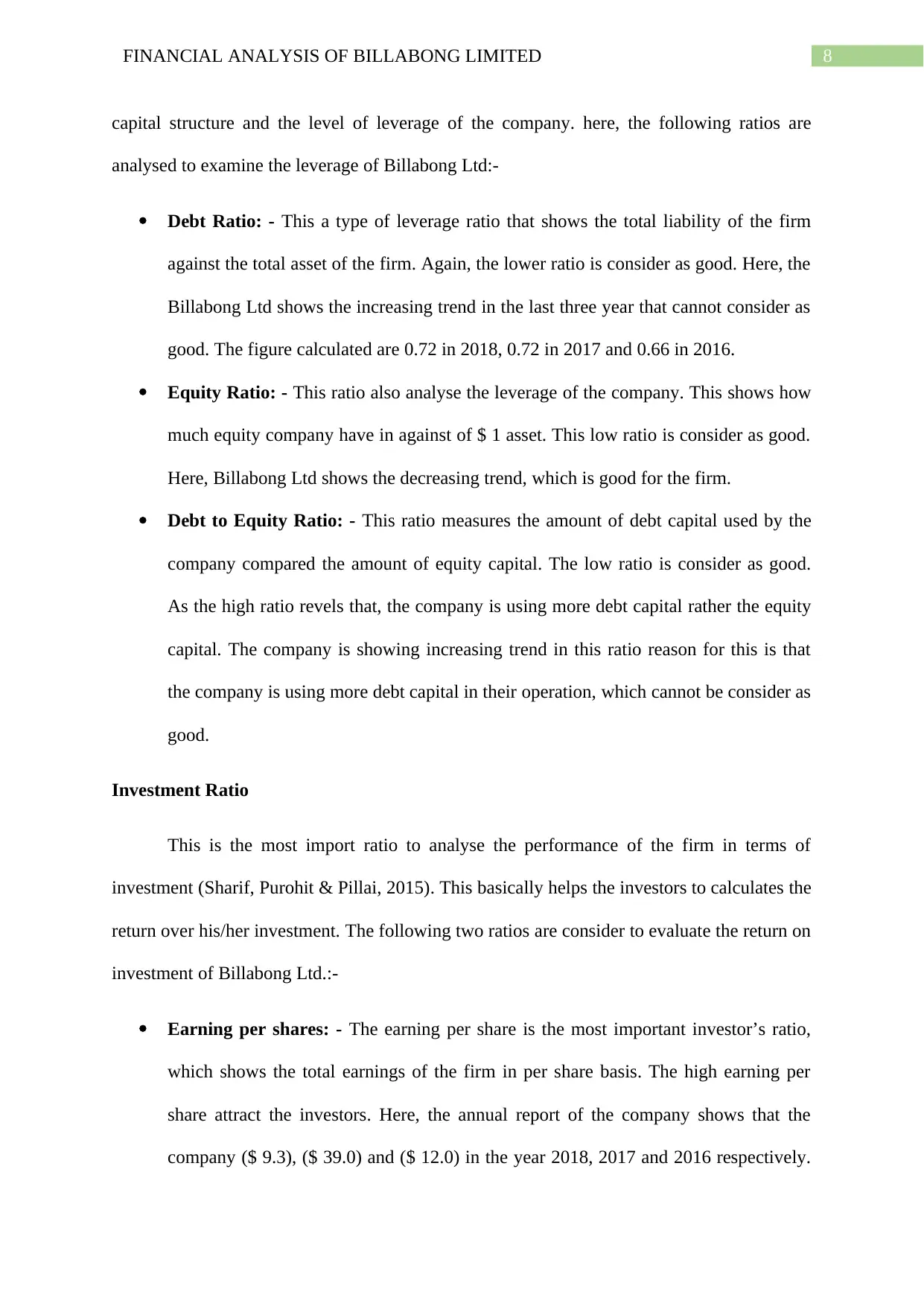
8FINANCIAL ANALYSIS OF BILLABONG LIMITED
capital structure and the level of leverage of the company. here, the following ratios are
analysed to examine the leverage of Billabong Ltd:-
Debt Ratio: - This a type of leverage ratio that shows the total liability of the firm
against the total asset of the firm. Again, the lower ratio is consider as good. Here, the
Billabong Ltd shows the increasing trend in the last three year that cannot consider as
good. The figure calculated are 0.72 in 2018, 0.72 in 2017 and 0.66 in 2016.
Equity Ratio: - This ratio also analyse the leverage of the company. This shows how
much equity company have in against of $ 1 asset. This low ratio is consider as good.
Here, Billabong Ltd shows the decreasing trend, which is good for the firm.
Debt to Equity Ratio: - This ratio measures the amount of debt capital used by the
company compared the amount of equity capital. The low ratio is consider as good.
As the high ratio revels that, the company is using more debt capital rather the equity
capital. The company is showing increasing trend in this ratio reason for this is that
the company is using more debt capital in their operation, which cannot be consider as
good.
Investment Ratio
This is the most import ratio to analyse the performance of the firm in terms of
investment (Sharif, Purohit & Pillai, 2015). This basically helps the investors to calculates the
return over his/her investment. The following two ratios are consider to evaluate the return on
investment of Billabong Ltd.:-
Earning per shares: - The earning per share is the most important investor’s ratio,
which shows the total earnings of the firm in per share basis. The high earning per
share attract the investors. Here, the annual report of the company shows that the
company ($ 9.3), ($ 39.0) and ($ 12.0) in the year 2018, 2017 and 2016 respectively.
capital structure and the level of leverage of the company. here, the following ratios are
analysed to examine the leverage of Billabong Ltd:-
Debt Ratio: - This a type of leverage ratio that shows the total liability of the firm
against the total asset of the firm. Again, the lower ratio is consider as good. Here, the
Billabong Ltd shows the increasing trend in the last three year that cannot consider as
good. The figure calculated are 0.72 in 2018, 0.72 in 2017 and 0.66 in 2016.
Equity Ratio: - This ratio also analyse the leverage of the company. This shows how
much equity company have in against of $ 1 asset. This low ratio is consider as good.
Here, Billabong Ltd shows the decreasing trend, which is good for the firm.
Debt to Equity Ratio: - This ratio measures the amount of debt capital used by the
company compared the amount of equity capital. The low ratio is consider as good.
As the high ratio revels that, the company is using more debt capital rather the equity
capital. The company is showing increasing trend in this ratio reason for this is that
the company is using more debt capital in their operation, which cannot be consider as
good.
Investment Ratio
This is the most import ratio to analyse the performance of the firm in terms of
investment (Sharif, Purohit & Pillai, 2015). This basically helps the investors to calculates the
return over his/her investment. The following two ratios are consider to evaluate the return on
investment of Billabong Ltd.:-
Earning per shares: - The earning per share is the most important investor’s ratio,
which shows the total earnings of the firm in per share basis. The high earning per
share attract the investors. Here, the annual report of the company shows that the
company ($ 9.3), ($ 39.0) and ($ 12.0) in the year 2018, 2017 and 2016 respectively.
⊘ This is a preview!⊘
Do you want full access?
Subscribe today to unlock all pages.

Trusted by 1+ million students worldwide
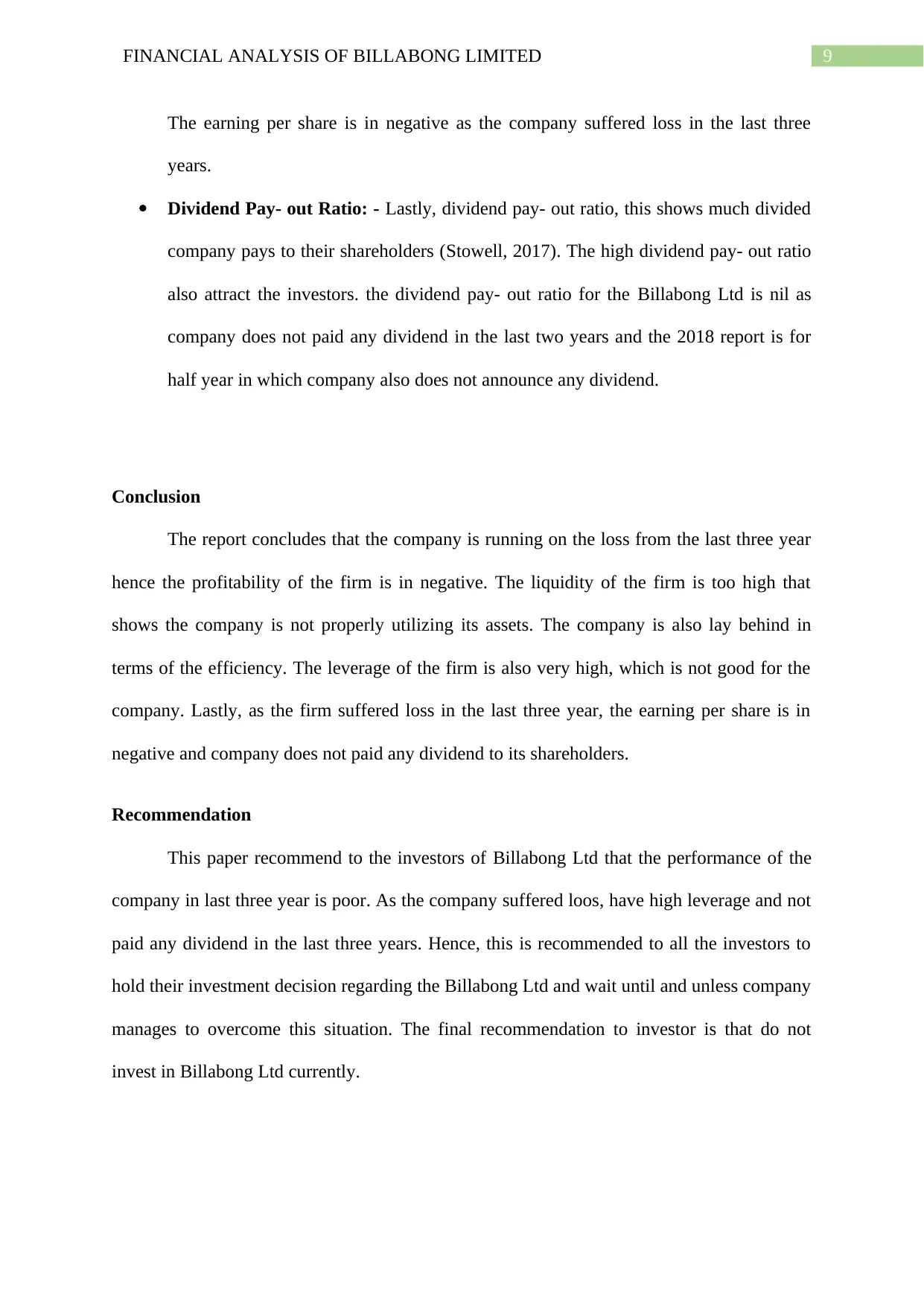
9FINANCIAL ANALYSIS OF BILLABONG LIMITED
The earning per share is in negative as the company suffered loss in the last three
years.
Dividend Pay- out Ratio: - Lastly, dividend pay- out ratio, this shows much divided
company pays to their shareholders (Stowell, 2017). The high dividend pay- out ratio
also attract the investors. the dividend pay- out ratio for the Billabong Ltd is nil as
company does not paid any dividend in the last two years and the 2018 report is for
half year in which company also does not announce any dividend.
Conclusion
The report concludes that the company is running on the loss from the last three year
hence the profitability of the firm is in negative. The liquidity of the firm is too high that
shows the company is not properly utilizing its assets. The company is also lay behind in
terms of the efficiency. The leverage of the firm is also very high, which is not good for the
company. Lastly, as the firm suffered loss in the last three year, the earning per share is in
negative and company does not paid any dividend to its shareholders.
Recommendation
This paper recommend to the investors of Billabong Ltd that the performance of the
company in last three year is poor. As the company suffered loos, have high leverage and not
paid any dividend in the last three years. Hence, this is recommended to all the investors to
hold their investment decision regarding the Billabong Ltd and wait until and unless company
manages to overcome this situation. The final recommendation to investor is that do not
invest in Billabong Ltd currently.
The earning per share is in negative as the company suffered loss in the last three
years.
Dividend Pay- out Ratio: - Lastly, dividend pay- out ratio, this shows much divided
company pays to their shareholders (Stowell, 2017). The high dividend pay- out ratio
also attract the investors. the dividend pay- out ratio for the Billabong Ltd is nil as
company does not paid any dividend in the last two years and the 2018 report is for
half year in which company also does not announce any dividend.
Conclusion
The report concludes that the company is running on the loss from the last three year
hence the profitability of the firm is in negative. The liquidity of the firm is too high that
shows the company is not properly utilizing its assets. The company is also lay behind in
terms of the efficiency. The leverage of the firm is also very high, which is not good for the
company. Lastly, as the firm suffered loss in the last three year, the earning per share is in
negative and company does not paid any dividend to its shareholders.
Recommendation
This paper recommend to the investors of Billabong Ltd that the performance of the
company in last three year is poor. As the company suffered loos, have high leverage and not
paid any dividend in the last three years. Hence, this is recommended to all the investors to
hold their investment decision regarding the Billabong Ltd and wait until and unless company
manages to overcome this situation. The final recommendation to investor is that do not
invest in Billabong Ltd currently.
Paraphrase This Document
Need a fresh take? Get an instant paraphrase of this document with our AI Paraphraser

10FINANCIAL ANALYSIS OF BILLABONG LIMITED
References
Anwar, S., Fathoni, A., & Gagah, E. (2018). ANALYSIS OF THE EFFECT OF CURRENT
RATIO, TOTAL TURN OVER ASSETS, DEBT TO EQUITY RATIO AND NET
PROFIT MAGRIN ON CHANGES OF PROFIT WITH ON EQUITY RETURN AS
INTERVENING VARIABLES ON PHARMACEUTICAL COMPANIES LISTED
IN INDONESIA STOCK EXCHANGE (BEI) 2013-2017 PERIOD. Journal of
Management, 4(4).
Bhootra, A. (2018). Gross profitability and momentum. Managerial Finance, 44(8), 992-
1011.
Khamidah, A., Gagah, E., & Fathoni, A. (2018). ANALYSIS OF THE EFFECT OF GROSS
PROFIT MARGIN (GPM), EARNING PER SHARE (EPS), DEBT TO EQUITY
RATIO (DER), NET PROFIT MARGIN (NPM) ON RETURN ON ASSETS (ROA)
(Study On Property and Real Estate Companies listed on the Indonesia Stock
Exchange Year 2012–2016). Journal of Management, 4(4).
Mathuva, D. (2015). The Influence of working capital management components on corporate
profitability.
Olesen, O. B., Petersen, N. C., & Podinovski, V. V. (2015). Efficiency analysis with ratio
measures. European Journal of Operational Research, 245(2), 446-462.
Patil, A., Kenjale, P., & Kanade, A. (2017, April). IFRS Impact on Profitability and Liquidity
Parameters for the Indian IT Sector-Case Study Approach. In International
Conference on" Emerging Trends in Applied Finance and Business Economics.
Robinson, T. R., Henry, E., Pirie, W. L., & Broihahn, M. A. (2015). International financial
statement analysis. John Wiley & Sons.
References
Anwar, S., Fathoni, A., & Gagah, E. (2018). ANALYSIS OF THE EFFECT OF CURRENT
RATIO, TOTAL TURN OVER ASSETS, DEBT TO EQUITY RATIO AND NET
PROFIT MAGRIN ON CHANGES OF PROFIT WITH ON EQUITY RETURN AS
INTERVENING VARIABLES ON PHARMACEUTICAL COMPANIES LISTED
IN INDONESIA STOCK EXCHANGE (BEI) 2013-2017 PERIOD. Journal of
Management, 4(4).
Bhootra, A. (2018). Gross profitability and momentum. Managerial Finance, 44(8), 992-
1011.
Khamidah, A., Gagah, E., & Fathoni, A. (2018). ANALYSIS OF THE EFFECT OF GROSS
PROFIT MARGIN (GPM), EARNING PER SHARE (EPS), DEBT TO EQUITY
RATIO (DER), NET PROFIT MARGIN (NPM) ON RETURN ON ASSETS (ROA)
(Study On Property and Real Estate Companies listed on the Indonesia Stock
Exchange Year 2012–2016). Journal of Management, 4(4).
Mathuva, D. (2015). The Influence of working capital management components on corporate
profitability.
Olesen, O. B., Petersen, N. C., & Podinovski, V. V. (2015). Efficiency analysis with ratio
measures. European Journal of Operational Research, 245(2), 446-462.
Patil, A., Kenjale, P., & Kanade, A. (2017, April). IFRS Impact on Profitability and Liquidity
Parameters for the Indian IT Sector-Case Study Approach. In International
Conference on" Emerging Trends in Applied Finance and Business Economics.
Robinson, T. R., Henry, E., Pirie, W. L., & Broihahn, M. A. (2015). International financial
statement analysis. John Wiley & Sons.
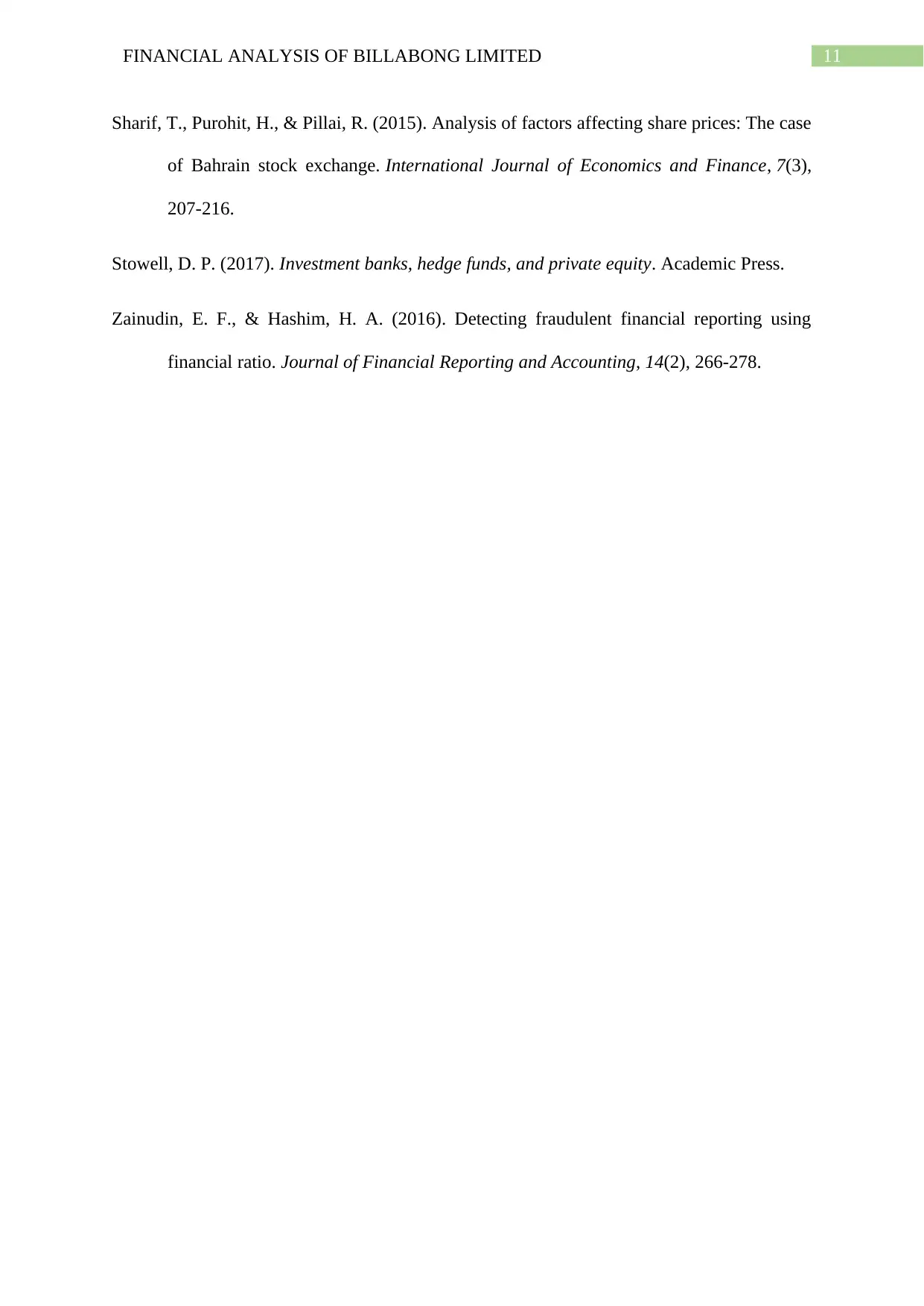
11FINANCIAL ANALYSIS OF BILLABONG LIMITED
Sharif, T., Purohit, H., & Pillai, R. (2015). Analysis of factors affecting share prices: The case
of Bahrain stock exchange. International Journal of Economics and Finance, 7(3),
207-216.
Stowell, D. P. (2017). Investment banks, hedge funds, and private equity. Academic Press.
Zainudin, E. F., & Hashim, H. A. (2016). Detecting fraudulent financial reporting using
financial ratio. Journal of Financial Reporting and Accounting, 14(2), 266-278.
Sharif, T., Purohit, H., & Pillai, R. (2015). Analysis of factors affecting share prices: The case
of Bahrain stock exchange. International Journal of Economics and Finance, 7(3),
207-216.
Stowell, D. P. (2017). Investment banks, hedge funds, and private equity. Academic Press.
Zainudin, E. F., & Hashim, H. A. (2016). Detecting fraudulent financial reporting using
financial ratio. Journal of Financial Reporting and Accounting, 14(2), 266-278.
⊘ This is a preview!⊘
Do you want full access?
Subscribe today to unlock all pages.

Trusted by 1+ million students worldwide
1 out of 13
Related Documents
Your All-in-One AI-Powered Toolkit for Academic Success.
+13062052269
info@desklib.com
Available 24*7 on WhatsApp / Email
![[object Object]](/_next/static/media/star-bottom.7253800d.svg)
Unlock your academic potential
Copyright © 2020–2025 A2Z Services. All Rights Reserved. Developed and managed by ZUCOL.





